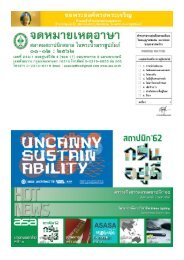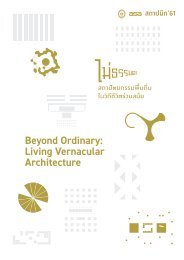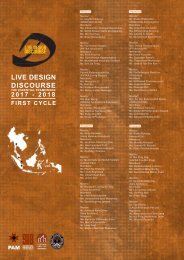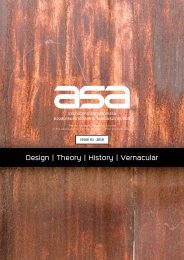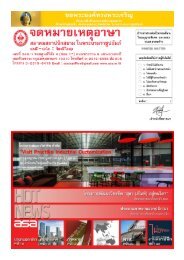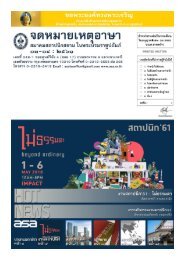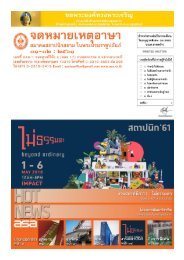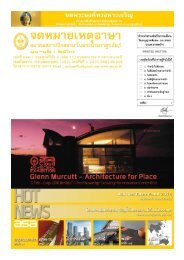ASA JOURNAL Vol.2 | 2018
You also want an ePaper? Increase the reach of your titles
YUMPU automatically turns print PDFs into web optimized ePapers that Google loves.
Reflections on the Shophouse Facades Development of the<br />
Andaman Sea - Malay Peninsula Port Towns<br />
Pat Wongpradit, Ph.D. Candidate<br />
Vernacular Architecture Programme, Faculty of Architecture, Silpakorn University, BKK, Thailand / pa_patm@hotmail.com<br />
Thesis Advisor: Kreangkrai Kirdsiri, Ph.D.<br />
Lecturer, Department of Architecture, Faculty of Architecture, Silpakorn University / arch.su.kreangkrai@gmail.com<br />
Abstract<br />
This study investigates the shophouse facades development of various typologies from the 18th to the 20th century<br />
focusing on 4 port towns on the Andaman Sea-Malay Peninsula: Kantan, Phuket and Takuapa in Thailand; and Penang in<br />
Malaysia. The study is carried out by researching documents along with site surveys and measurements in order to examine<br />
physical characteristics and styles of the areas. The findings indicate that the evolution of shophouse façades can be sequentially<br />
categorised into seven styles which are: 1) The 1st Localized Style; 2) The 2nd Localized Style; 3) The 1st Eclectic Style;<br />
4) The 2nd Eclectic Style; 5) The 3rd Eclectic Style; 6) Art Deco Style; and 7) Early Modern Style.<br />
Keywords: Shophouse Facade I Port town I Andaman Sea-Malay Peninsula<br />
Background<br />
Southeast Asia is renowned as a location along the<br />
maritime trade route from India to China for centuries. Western<br />
countries perceive this region as “Indo China” spanning from<br />
the Coromandel Sea in India to the Andaman Sea in Southeast<br />
Asia and Strait of Malacca in the Malay Peninsula where it is<br />
a changing point of monsoon winds. This area is an anchorage<br />
point along the monsoon area and communities were established<br />
for local trading. The trading began from the interchange<br />
of local goods with imports that were used for ceremonies or<br />
to be collected as family treasures. This trading system created<br />
centrality which comprises of manufacturers, exporters and<br />
sellers. Some areas that were in a good location developed as<br />
an “Entrepot” or Port towns and Emporiums (Thida. 2011:<br />
432).<br />
The significant port towns on the Southern Peninsula<br />
of Thailand and Malay Peninsula are Malacca, Singapore,<br />
Penang, Pattani, Songkhla, Kelantan, Thalang, Takuapa and<br />
others. These seaports are connected through the “Peninsula<br />
Shipping Route” along with other types of transportation including<br />
rafts, horse carts, horses, elephants and other animals<br />
used as vehicles. Wheatly Paul compiled 11 routes that were<br />
widely used from the past until present time such as the Kra<br />
Isthmus, the Takuapa River, the Trang River, Kedah-Pattani,<br />
Kelanran-Melaka and others (Wheatly. 1961). These routes<br />
reflect the development of seaports in both upper and lower<br />
parts of the peninsula related to successive trading.<br />
Apart from geographical factors that influenced the<br />
position of the port towns, abundant resources made the<br />
location of the southern peninsula and the Malay Peninsula a<br />
fascinating destination for traders along the maritime route.<br />
Chinese, Siamese and Europeans such as Portuguese, Hollandic<br />
and British continued to have influences on the area. This was<br />
the period that cultures were inherited and cultural evidences<br />
were manifested. These relationships can be seen in “Shophouse<br />
architecture” in several port towns. Consequently, in<br />
the study of shophouses, it is necessary to mention of two<br />
principal groups that are influential in the area of southern<br />
peninsula and the Malay Peninsula.<br />
Literature review<br />
According to Paul Oliver’s Encyclopedia of Vernacular<br />
Architecture, it is considered that the creation of “Shophouse”<br />
was the result of in the need of functions (Paul Oliver, 1998:<br />
21). It is in agreement with Julian Davison’s explanation stating<br />
that the shophouse is a kind of architecture which accommodates<br />
both commercial and residential purposes in one building.<br />
Shophouses are generally found along streets as it is convenient<br />
To explain and understand the shophouse facade development<br />
in western port towns along the Andaman Sea, it<br />
is crucial to study relationships between those port towns and<br />
Penang, where it is the main trading station in the Strait Settlement<br />
for maritime merchants to run a business in the<br />
Malay Peninsula.<br />
Therefore, “Reflections on the Shophouse Facades<br />
Development of the Andaman Sea-Malay Peninsula Port<br />
Towns” aims to study shophouses in the historic urban landscape<br />
of port towns which are: Takua Pa (Phangnga province),<br />
Thalang (Phuket province) and Kelantan (Trang province) in<br />
the Andaman Sea of Thailand; and George Town (Penang) in<br />
Malay Peninsula. The research question is: What is the develfor<br />
trading activities. The owners run a business on the ground<br />
floor and live in the back side and on the first floor of shophouse.<br />
Regarding the form and facade of shophouses, Julian<br />
Davison and Tan Yeow Wooi both have a general agreement<br />
on the definition of the shophouse as a building that is two or<br />
three stories high. Shophouses also have narrow but long form.<br />
The ground floor façade is recessed from the street edge while<br />
the façade on the upper floor projects out towards the road<br />
line and covers the pavement below. This upper wall transfers<br />
weight to the columns. In each block, there are shared party<br />
walls between shophouses and their neighbors on either side.<br />
Normally shophouses are built continuously along the road<br />
therefore the area in front of the buildings can be used as a<br />
covered walkway or so called “Five-foot way” which provides<br />
pedestrians shade from the sun and rain. The structure and<br />
general materials in shophouse are mainly from timber and<br />
masonry.<br />
The shophouse is a unique building type which was the<br />
outcome of the culture of Chinese people who migrated from<br />
China. According to the Encyclopedia of Vernacular Architecture<br />
(Paul Oliver. 1998: 657), the shophouse was initially<br />
built under Chinese influence in the area of the Malay Peninsula<br />
and continuously developed in its identity. This was<br />
particularly the case for the port towns that became prosperous<br />
from settlement as commercial coast stations, trading<br />
stations, and sources of consumer goods needed for travel.<br />
The role of the Commonwealth of England (British East India<br />
Company) in Southeast Asia had influences through the Straits<br />
Settlements in 1862 which consisted of Penang, Singapore and<br />
Malacca. The capital of the trading stations was George Town<br />
in Penang. Consequently, prosperity increased in port towns<br />
in the Malay Peninsula. The establishment of shophouses along<br />
with urban development started since the 18th century.<br />
In the meantime, port towns in the Southern Peninsula<br />
of Thailand grew and developed concurrently and also<br />
connected through marine trading as can be seen from shophouses<br />
in port towns such as Pattani, Songkla, Nakhorn Si<br />
Thammarat, Kelantan Phuket and Takua Pa. A considerable<br />
amount of relevant literature has been published. Wasan<br />
Cheewasat indicated that Chinese architecture had an influence<br />
on shophouses in Pattani. His holistic study revealed a development<br />
of architectural style through historical aspects<br />
(Wasan, 1996). A study of Sino-Portuguese architecture in<br />
Nakorn Si Thammarat province written by Udom Nuthong<br />
and Mano Pisootrattananon (2000) focused on the architecture<br />
study through a historical point of view together with giving<br />
case studies for analyses. The existing literature on the old<br />
community of Songkhla Province focuses particularly on local<br />
history, culture and urban physical characteristics. Regarding<br />
shophouse study in architectural detail, Supawadee Chuapram<br />
revealed that shophouses in Songkla old town has explicit<br />
images of Chinese culture from their lifestyle to the architecture.<br />
It is demonstrated through the evolution of shophouses<br />
which blended Chinese-Thai, Chinese-Western and modern<br />
styles (Supawadee, 2003). The research conducted by Dhanaraj<br />
Thavaroj explored ways in which shophouses were established<br />
in the old commercial districts of Eastern seaports on Thailand’s<br />
Southern peninsula. The study highlighted that important<br />
factors of shophouse creation were geographic features<br />
and Chinese immigration. The development of the shophouse<br />
was represented in the Traditional Chinese style, the Chinese-Vernacular<br />
Thai style and Chinese-European style<br />
(Dhanaraj, 2004).<br />
Literature review clearly resulted in a large amount of available<br />
literature on the architectural study of shophouses in Eastern<br />
port towns in Southern Peninsula of Thailand. Together these<br />
studies provided important insights into the explanation of<br />
the shophouse development. However, there has been no reliable<br />
evidence of architectural knowledge of shophouse in<br />
Eastern port towns in Southern Peninsula of Thailand.<br />
Research questions<br />
54 55<br />
วารสารสถาปัตยกรรมของสมาคมสถาปนิกสยาม<br />
ในพระบรมราชูปถัมภ์ Issue 02 / <strong>2018</strong><br />
Academic Journal of The Association of Siamese Architects<br />
under the Royal Patronage<br />
วารสารสถาปัตยกรรมของสมาคมสถาปนิกสยาม<br />
ในพระบรมราชูปถัมภ์ Issue 02 / <strong>2018</strong><br />
Academic Journal of The Association of Siamese Architects<br />
under the Royal Patronage





